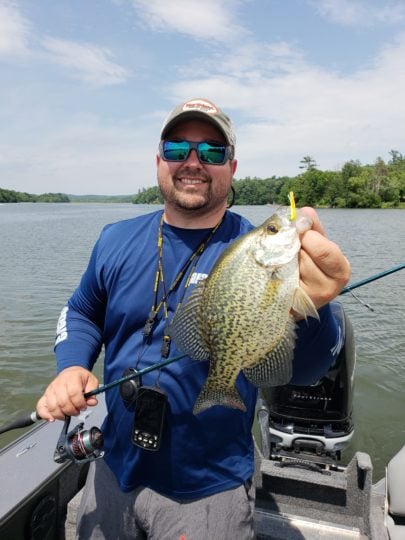
I’ve found that most people who casually fish for crappies have a sort of seasonal affective disorder for the species, being entirely giddy for spring runs to the shallows and generally depressed regarding the prospect of catching one after the early-season boom. Or maybe you’re just into fishing for them while the fishing is good, which most certainly isn’t a bad thing. It may surprise you to hear that the fishing for summer crappies right now can be really good. As in “great,” you just need to fish for them differently.
Summer crappies are notoriously difficult to find, as they truly seem to be nomadic in nature, occupying different depths, relating to different cover, and many times targeting a variety of forage in differing parts of the lake. A few summers ago while on the same lake, fishing the same day, I caught crappies in 5 feet of water in lily pads, in 10-15 feet of water slow-rolling small plastics over deeper weed edges, and in 20+ feet of water pulling crawler harnesses for walleyes. This would seem like a good thing, right? Being that they’re everywhere, they should be easy to catch. Yes and no is typically the answer to that question, with onesies and twosies often being the order of the day.
One of the better patterns I’ve observed in recent memory is actually something a good friend, and fisheries biologist turned me onto. We dropped into a small and relatively clear Ottertail county lake around 7 PM that evening, looking to fish some crappies that he recently had been getting into. The boat stopped past the weedline. Thinking to myself that we’d missed our intended target, my first cast was a bomb, back to the shelter of weeds, while Brandon’s was out into the open water. He engaged the trolling motor, and within a minute had missed two and boated one. We fished from the weedline out, towards the middle of the lake, with continual clumps of bait and fish graphing 5 – 15 feet down in anywhere from 12 – 30 feet of water. This clutter was the bait our fish were feeding on and is very easy to overlook on your sonar, however, whenever it was on the screen, we were popping fish on a consistent basis.
This technique is a slow trolling one, with depth being controlled by speed, size of bait, and length of the cast. “How far should I cast,” I asked Brandon? “A good cast behind the boat, and then one pull of line off the reel,” he said. Precise. In a very vague and general sort of way. This told me that I needn’t be too fussy at least that day. Jig size proved to be a bit more important. We both had 1/16 oz boot-tails like the Mimic Minnow Shad varieties, at least at first. After getting the feel for it, I was putting some serious heat to the fish early, with my buddy doing far better during the latter half of our evening. The later comparison showed he was using a 1/32 oz jig, thus covering that 5-10FOW region far better as fished moved up in the water column later in the evening. When we were marking fish more in that 10-15 foot depths earlier that night, the 1/16 oz jig I was using got down and in their face far better.
From there, you keep the jig moving, subtly. Pull too aggressively, and you simply miss fish or they miss you. Not moving it at all seemed to produce short strikes and fish that didn’t fully latch on. You want them to react in a quick and decisive manner, taking the bait fully into their mouths, and keeping that bait moving with short pulls seemed to accomplish that task. If you hook up on multiple fish in the same location, you can always stop and cast. The only problem with that is that different baits count down to different depths, and retrieves rarely are consistent enough to keep you at the same depth, which makes the trolling part of this pattern work so well.
I had a chance to confer with fellow panfish fanatic and guide Tony Roach on the technique, just a few days after, and he confessed to using it on other systems, especially clear ones, in the northern half of the state. Roach said, “It’s funny, I don’t see many other people out there doing it, but it’s literally THE way to get bit on certain bodies of water.” Who am I to argue with the fish or Tony for that matter? While there can be lots of ways to catch a few crappies during the latter half of the summer, few I’ve seen have made me feel like it’s early spring again.

